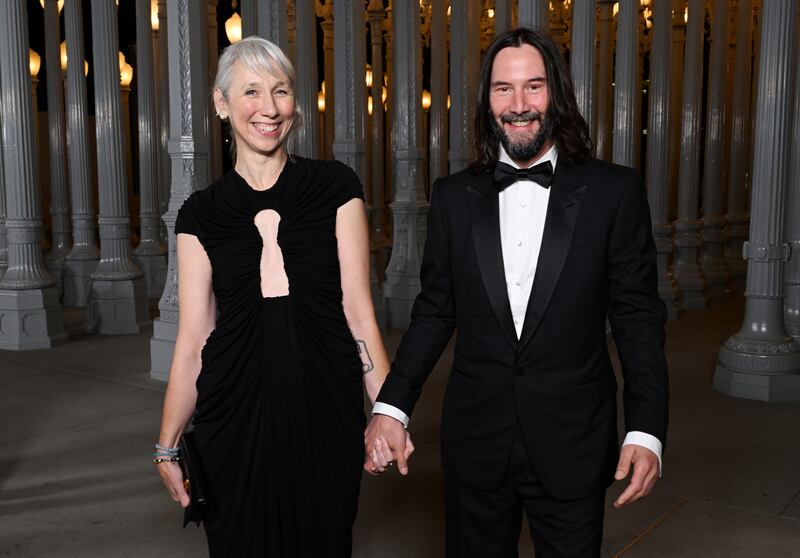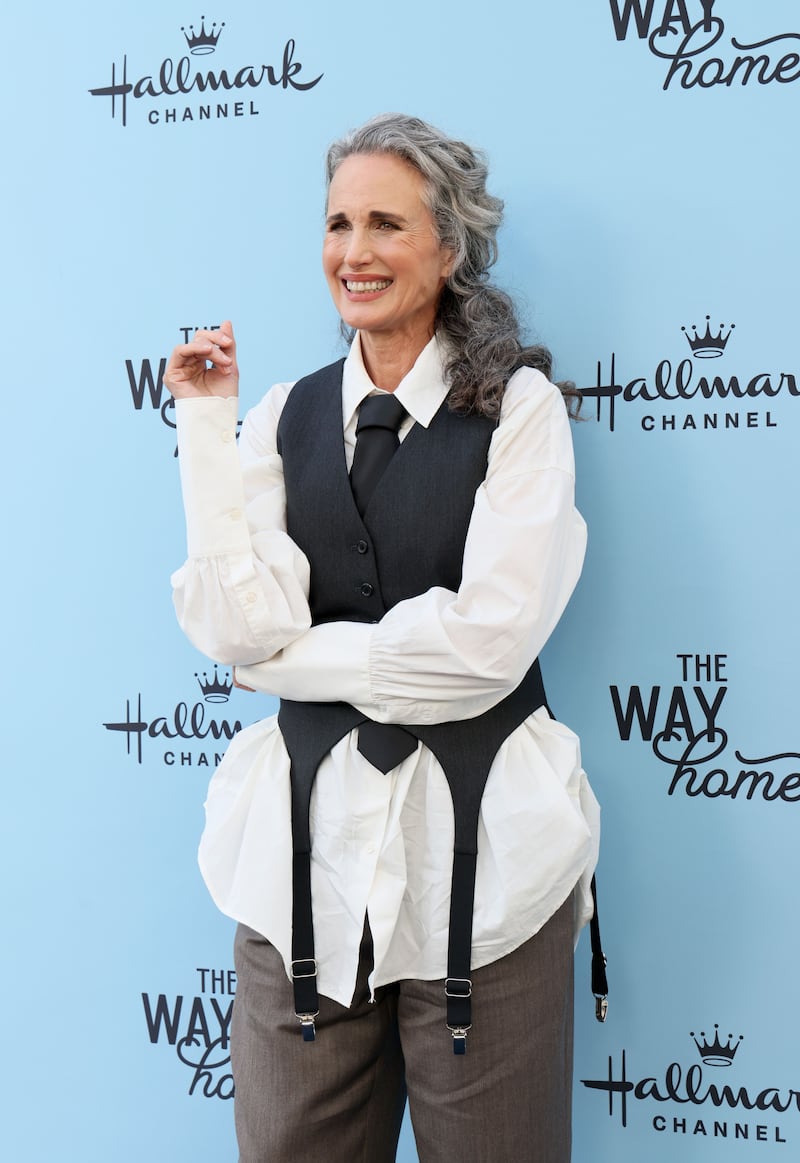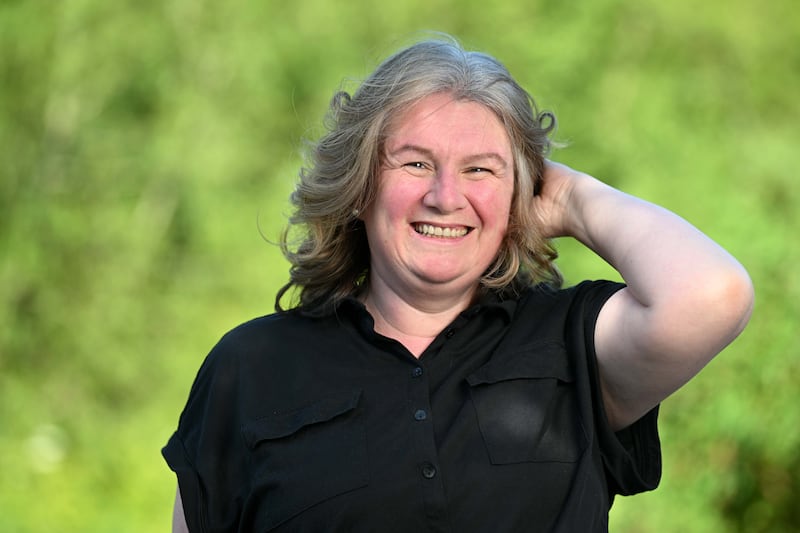Women can do whatever they want with their hair, right? Then why is having visibly grey roots so controversial? It’s because grey hair on women is still mostly unacceptable, at least not until they are deemed “old enough”.
Grey-shaming is part of a culture that tells women they mustn’t display any signs of ageing. Growing out to grey is a slow process, and so is changing society’s perceptions. A woman “caught’” with grey roots is nearly always news.
When the actress Sarah Jessica Parker was photographed by paparazzi walking in New York in July 2021, with what may or may not have been some grey hair, she made headlines. When, a week later, she was photographed eating lunch, still with the same hair, it was even more newsworthy.
“Sarah Jessica Parker, 56, continues to proudly show off her grey hair,” read the Daily Mail headline.
Sally Rooney: ‘I enjoy writing about men ... the dangerous charisma of the oppressor class’
Alzheimer’s: ‘I’ve lost my friend and my companion,’ says Úna Crawford O’Brien of fellow Fair City actor Bryan Murray
Ryan Adams at Vicar Street: A gig that nobody will forget anytime soon, but perhaps not for all the right reasons
This woman eating salad was – stop the press – still not dealing with her hair. The publication of the pictures was a veiled shaming, yet she wasn’t demonstrating shame. She was transgressing beauty norms, and was defiant about it.
That Parker’s three-years-younger male lunch date, television presenter Andy Cohen, was completely grey-haired didn’t get a mention. “Why is it okay for him?” Parker asked US Vogue.
What about Alexandra Grant, girlfriend of the 58-year-old actor Keanu Reeves – after their first appearance on the red carpet together, the 54-year-old visual artist drew the tabloid headline, Why she refuses to dye her grey hair. His white-streaked beard didn’t need explaining.
If you’re a woman who dyes her hair or shows her grey – who cares? We care a lot, it seems.

Grey hair is a sign of ageing for women: that’s a biological fact. But we live a lot longer these days, and that changes how we should interpret signs of ageing. For most of humans’ time on the planet, our evolutionary duty to procreate was achieved in our teens to early 20s.
“Greying hair, along with most of our body bits, start to head south in the mid to late 20s,” says Prof Des Tobin of UCD’s Charles Institute of Dermatology. “Any characteristics that we see in our 30s, 40s, 50s and 60s are in a different category from the drive of nature; 30 is old in evolutionary terms.
“In terms of a rule of thumb, by age 40, 40 per cent of hair follicles on the average Caucasian scalp will be white,” he adds. It happens later for those of African or far east Asian ancestry, such as those who are Japanese or Chinese. “It’s absolutely quite appropriate for Caucasians to be greying by their 30s.”
Humans are now living far beyond their procreative prime. These days, when we are over the hill from an evolutionary or reproductive perspective, we haven’t even reached the top of it from an age perspective.
“The classic example now is menopause,” says Prof Tobin. “Many women now will be spending more of their lives post-menopause than pre-menopause.”
Human biology and longevity are no longer in sync. A beauty standard that demands the normal biological signs of ageing that occur from our 20s like greying hair be stalled as we live ever longer is totally out of whack.
Beauty standards that require women to mask signs of ageing put women at war with their bodies. The pandemic was a turning point for many.
Pre-pandemic, the actor Andie MacDowell had been curious about leaning in to her natural salt-and-pepper hair. “I thought it would look good on my face. And when it started growing out during Covid, I saw I was right. It looks good on me,” she said in interviews.

“It empowered me more. I felt more powerful and more myself.”
Indeed, the pandemic brought many reckonings. History may show that a normalisation of natural-coloured hair on women was one of them.
“During Covid, it was much less of a taboo for women to have grey hair because there was nothing you could do about it,” says Kon Kelly, an award-winning hair educator at Peter Mark.
“People were going to the shop with their regrowth visible and they wouldn’t have dreamed of doing that before. It was so down people’s list of priorities.”
[ Simone Gannon: My picks for the best sunscreen for every skin typeOpens in new window ]
During lockdown, women could experience grey hair judgment-free. They weren’t being “brave”, “letting themselves go”, or making a feminist statement – they just didn’t have a choice.
Being out of the office, off the red carpet or the school run meant the sometimes tough initial phase of grow-out, with its hard demarcation line between white roots and dyed hair, could be ridden out less publicly.
“Post-lockdown, clients came in and they had so much regrowth, they had a choice,” says Kelly. “They had got comfortable seeing themselves with grey hair.”
While hairdressing was among the most-missed services during lockdown, the closure of salons meant a break from the treadmill of dyeing.
With hair growing about half an inch a month, keeping grey at bay can be a time-consuming, expensive and dispiriting game of whack-a-mole. Those aged from their late 30s to their 70s will need a permanent colour at least every six weeks, says Kelly.
Many darker haired women dye their hair blonde to mask grey regrowth for longer. “We have blonde clients, whose natural hair would be almost 100 per cent white, they would be getting some highlights and lowlights every eight to 12 weeks,” says Kelly.
If you want a sense of how many may be doing this, look around. “Only 2-3 per cent of women in Ireland in adulthood will have naturally blonde hair. After puberty, it’s very rare,” says Prof Tobin. Those with sprinkling of greys, typically in their 20s and 30s, disguise them with less frequent highlights, says Kelly.
Depending on your hair and the salon, the cost for grey coverage will range from €100-€300 per visit. It will take two hours for an all-over colour. Add highlights and blending and it’s three hours, says Kelly.
That’s up to €2,600 and 26 hours a year spent on covering grey – less if you dye it at home.
When it comes to accepting their silver hairs, it tends to be younger rather than older women who are doing so, says Kelly. “What I’ve noticed is that the older generation of clients are still not ready to embrace it – after the [pandemic-related] closures, that generation still wanted to have their hair coloured. They still see grey as being a negative and they want coverage come hell or high water.”
Clients in their 30s, 40s and 50s are more exposed to slowly changing representations of beauty, he thinks. “Alicia Keys is make-up free. Pamela Anderson is make-up free. Actresses are now embracing their white hair, so they see that and are less scared of it.”
Indeed, even before the pandemic, fashion had started to flirt with grey, says Kelly. Younger women with no grey to hide were dabbling in platinum and pearlescent colours.
It was seeing the example of her younger fans that made Andie MacDowell more confident to go grey, she has said. “I think the younger generation is tired of the status quo. The younger generations perceive women as being much more powerful than we perceive ourselves. Because we grew up in a generation when we were taught to disempower ourselves, and they don’t want that.”
Comments about MacDowell’s greying hair making her “look older” just make her laugh, she said in an interview with Katie Couric last year.
“How old do you think I look? I’m going to be 65. What, do you think I look 75 just because I let my hair go grey?” she said. “I don’t care. I want to be old. I’m tired of trying to be young. I don’t want to be young. I’ve been young.
“And to be an older person trying to be young, what an effort,” she shared. “I just can’t keep up the charade! I can’t!”
Dr Jacqui O’Riordan’s hair started to turn grey in her 30s. She dyed it for a while, and enjoyed going to the hair salon before starting to question things.
“I was thinking, do I really want to do this, why am I doing this?” says Dr O’Riordan, an academic in the School of Applied Social Studies at UCC. “I could see my brothers going grey and they were fine. My husband was going grey and he was fine.
“It was, why do I have to look younger when I’m not? I don’t want to be 20 any more. I don’t want to be 30. I’m actually quite happy to be the age I am and I want to be seen. I don’t want to be pretending that I’m something I’m not.”
She stopped dyeing her hair in her early 50s. Embracing her natural grey hair for her was about becoming visible, not invisible.
“You are challenging the norm of having dyed hair. It’s a statement,” says O’Riordan (64).
Younger women these days are facing far stricter expectations around beauty than she did growing up, she says. She never engaged with make-up and has worn high heels once or twice in her life. Women are taught to battle their bodies, and that has increased, says O’Riordan.
“I see younger women in class or walking down the street now having to have make-up, hair, eyes, nails – things I wouldn’t even have had to think about as a young woman, and I still don’t think about them,” says Dr O’Riordan.
“That’s something you do, really? Not being able to leave the house without a huge paraphernalia or armour basically, in terms of clothes, make-up and image?”
Reality TV stars the Kardashians are arguably among the biggest influences on young female fashion. Four of the sisters – Kylie, Kim, Khloe and Kendall – are in the Forbes top 10 most followed Instagram accounts in the world. Their cosmetically enhanced aesthetic has spawned a plethora of products that generate billions in sales.
One sister is selling “precision pout” lips, another “your best butt ever bomb booty” jeans, while a third is flogging bras with a built-in raised nipple, described as giving a “perky”, “sexy”, yet “natural braless look”. The braless-look bra can be yours for €74, but there’s a waiting list.
Something natural to women – the nipple – is re-made into something synthetic and “better”, and then sold back to women as natural.
“It goes with an advanced capitalist society,” says O’Riordan. “The consumerism that we are pushed into in terms of our body image is huge. It’s to do with consumerism reaching further and further into our private lives.”
Opting out for some is about redefining what’s beautiful and acceptable, as well as reclaiming time, money and power from the beauty industry.
The upsides to her natural hair are many, says O’Riordan.
“It’s the health of my hair now, the lack of attention I have to give it, and the cost which was huge,” she says. “It coalesces more with my image of myself and my being in the world. I’m not following prescriptions about how I ought to look.
“Body image for women is so oppressive and time-consuming, and that idea that you have to look younger. I think we should challenge that and my being grey is a challenge to that.”
“The growing out is the hard part,” says Lyn Hagin Meade of the process of forgoing dyed hair for her natural grey.
Having started to go grey in her mid-20s, by her late 30s, the Green Party councillor for Firhouse-Bohernabreena decided to embrace it.
“The roots part, I sort of brazened it out and was happy to accept what it was,” she says.

Friends who continued to dye their hair in their 40s and 50s found her choice difficult, she thinks. “It wasn’t negative, it was just they didn’t feel they could make that choice personally.”
There can be a pressure among women to keep dyeing hair. “I think there is an expectation on women, they see their peers and they feel obliged to go along with what they see,” she says. “I liked the grey. I found it empowering. I enjoyed it. I sort of felt like it was me,” says 46-year-old Hagin Meade.
“I am this woman. It’s okay to get older or be a woman that isn’t the generic idea of womanhood that we see in the media. I could be authentic,” she says.
Hagin Meade was grey throughout her 40s. A mishap with a hair product she tried for fun and thought was temporary has her back to square one, however.
“I’m currently in the process of going back to grey after I made that error. I am longing to be grey again,” she says.
Hagin Meade is running for re-election this year, and the photo on her election posters will be grey-haired Lyn.
During the transition back to grey hair, however, she will use a wash-in wash-out dye until the grey is back.
“It’s not that I’m disguising the grey – the grey is what I want – it’s the transition. I’m more conscious that the transition is a difficult place to be when I am putting myself out there,” says Hagin Meade.
“It can be easy to see it as you are not looking after your hair, that it isn’t your priority to look professional. If you are letting it grow out, that’s a difficult space to be for a woman; it’s a difficult space for a professional woman,” she says.
A cold turkey grow-out to grey can be a hard look for women to pull off in a professional context. Female politicians know all about that.
When Democratic congresswoman for Massachusetts Katherine Clark stopped dyeing her grey hair at the age of 52, she wasn’t prepared for the backlash.
“Supporters pulled my staff aside and asked if I was ill because that was the only explanation they had for why I would age myself,” Clark said, in an article published on Boston public media site WBUR in 2022.
“People told me I would no longer be able to pass legislation, that I was throwing away my reputation as hard-working and, most confounding to me, that I would no longer be taken seriously. All of this because I had stopped colouring my grey hair?” It had not occurred to Clark, she writes, that her competence and effectiveness were contained within a small bottle of brown hair dye.
The backlash was a painful reminder of just how ingrained traditional beauty standards are in our culture and the double standards women face, said Clark. She has since been elected Democratic Whip, the highest-ranking woman in congressional leadership.
Women older than Hagin Meade have made assumptions about her grey hair too. “The most amusing reaction I get is a lot of older women can see the grey and tend to think I’m in the same age category as them,” she says.
“I embrace that because it’s given me a lot of insight into women of different ages. It’s made me more relatable maybe to a wider group of women which I think is really interesting and quite unexpected.”
The increasing number of women of all ages experimenting with natural grey hair, or dyed grey, white and pearlescent hair is blurring age lines and old norms, says Kon Kelly.
“We have clients in their 30s who have white hair and it’s trendy and cool. Walking down the street, I can’t tell if there is an older woman in front of me or a really trendy young person, so I think those walls are being broken down,” says Kelly.
Hagin Meade wants to normalise grey hair for women, no matter their age. “I will always be very open. I went grey in my 20s. That’s normal and that’s okay. I enjoy getting older, and that’s been a revelation to me.”
Feeling grey-curious? Then check out #silversisters. There is a whole ecosystem of grey-haired influencers on Instagram sharing their sometimes bumpy “journey” from grey roots to “grombre” to full grow-out.
@greyt_days_ahead, 2k followers
“Scottish silver sister, make-up enthusiast and tattoo aficionado.”
“Age 16 I started going grey, at 22 I’m embracing it.”
@jen.goes.grey, 34k followers
“Mum, wife, midwife, ‘embracing my grey in my 30s”
“I look around me and realise how same-same everyone else’s hair is. Same cuts, same colours, same styles. This makes me realise the reason my hair is even a talking point is because I’m not the same as everybody else. I stand out from the crowd.”
@randi_honeycutt_ 123k followers
“On a journey to silver hair. Last dye, Jan 2021.”
“‘Why did I quit colouring my hair? Tired of planning my life around my roots. Realised silver is just another colour.”
@moxieinmidlife 114k followers
“I’m 49, a wife, mother and educator. Follow me if you believe grey hair is beautiful, you know ageing is a gift and that there is no wrong way to age. I think people should live however they want.”
@sarahgrayandtall 68k followers
‘Millennial Grey’.
“Every single #silversister is paving the way the way for future generations to normalise grey hair.”
















